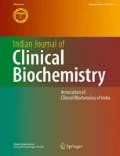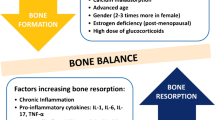Abstract
The present study was designed to test the hypothesis of a circadian variation in circulating levels of tumor necrosis factor-α (TNF-α) and interleukin-6 (IL-6) in women with fibromyalgia syndrome (FMS). Serum levels of IL-6 and TNF-α were measured at 4 h intervals of the day in 50 women with FMS satisfying American College of Rheumatology criteria for FMS (age 36.68 ± 9.89) as well as 50 healthy control women (age 32.82 ± 10.53). Serum TNF-α levels were substantially increased in patients with FMS but showed no circadian variation. In contrast, no difference in the levels of IL-6 was found. Moreover, there was also no circadian variation in both the groups of patients and controls. We conclude that no circadian pattern exists in the circulating levels of serum IL-6 and TNF-α in patients with FMS, although TNF-α levels are found raised in patients with FMS.
Similar content being viewed by others
References
Wolfe F, Smythe HA, Yunus MB, Bennett RM, Bombardier C, Goldenberg DL, Tugwell P, Campbell SM, Abeles M, Clark P. The American College of Rheumatology 1990 criteria for the classification of fibromyalgia. Report of the Multicenter Criteria Committee. Arthritis Rheum. 1990;33:160–72.
Häuser W, Zimmer C, Felde E, Kollner V. What are the key symptoms of fibromyalgia? Results of a survey of the German Fibromyalgia Association. Schmerz (Berlin, Germany). 2008;22:176–83.
Branco JC, Bannwarth B, Failde I, Abello Carbonell J, Blotman F, Spaeth M, Saraiva F, Nacci F, Thomas E, Caubere JP. Prevalence of fibromyalgia: a survey in five European countries. Arthritis Rheum. 2010;39:448–53.
Lawrence RC, Felson DT, Helmick CG, Arnold LM, Choi H, Deyo RA, Gabriel S, Hirsch R, Hochberg MC, Hunder GG. Estimates of the prevalence of arthritis and other rheumatic conditions in the United States. Part II. Arthritis Rheum. 2008;58:26–35.
Das SK, Srivastava S, Kumar P, Srivastava R, Bhattacharya D, Agarwal S, Agarwal GG. High prevalence of Fibromyalgia in both rural and urban area of Lucknow. JIRA. 2006;3(3):166.
Schaefer KM. Sleep disturbances linked to fibromyalgia. Holist Nurs Pract. 2003;17:120–7.
Rizzi M, Sarzi-Puttini P, Atzeni F. Cyclic alternating pattern: a new marker of sleep alteration in patients with fibromyalgia. J Rheumatol. 2004;31:1193–9.
McLean SA, Williams DA, Harris RE, Kop WJ, Groner KH, Ambrose K. Momentary relationship between cortisol secretion and symptoms in patients with fibromyalgia. Arthritis Rheum. 2006;54:2345–6.
Moldofsky H. Chronobiological influences on fibromyalgia syndrome: theoretical and therapeutic implications. Bailliere Clin Rheumatol. 1994;6:801–10.
Vgontzas AN, Bixler EO, Lin HM, Prolo P, Trakada G, Chrousos G. IL-6 and its circadian secretion in humans. Neuroimmunomodulation. 2005;12:131–40.
Vgontzas AN, Papanicolaou DA, Bixler EO. Elevation of plasma cytokines in disorders of excessive daytime sleepiness: role of sleep disturbance and obesity. J Clin Endocrinol Metab. 1997;82:1313–6.
Vgontzas AN, Papanicolaou DA, Bixler EO. Sleep apnea and daytime sleepiness and fatigue: relation to visceral obesity, insulin resistance, and hypercytokinemia. J Endocrinol Metab. 2000;85:1151–8.
Petrovsky N, Harrison LC. The chronobiology of human cytokine production. Int Rev Immunol. 1998;16:635–49.
Crofford LJ, Pillemer SR, Kalogeras KT. Hypothalamic–pituitary–adrenal axis perturbations in patients with fibromyalgia. Arthritis Rheum. 1994;37:1583–92.
Mc Cain GA, Tilbe KS. Diurnal hormone variation in fibromyalgia syndrome: a comparison with rheumatoid arthritis. J Rheumatol. 1989;16:154–7.
Burckhardt CS, Clark SR, Bennett RM. The fibromyalgia impact questionnaire: development and validation. J Rheumatol. 1991;18:728–33.
Wass J. Software: statistics, fast and easy. Science. 1998;282:1607–1741.
Mazzoccoli G, Carughi S, Sperandeo M. Neuro-endocrine correlations of hypothalamic–pitutary–thyroid axis in healthy humans. J Biol Regul Homeost Agents. 2011;25:249–57.
Goldenberg DL, Struzik ZR, Yamamoto Y, Togo F, Natelson BH, Adler GK, Ottenweller JE. Plasma cytokine fluctuations over time in healthy controls and patients with FMS. Exp Biol Med. 2009;234:232–40.
Hernandez ME, Becerril E, Perez M, Leff P. Proinflammatory cytokine levels in FM patients are independent of body mass index. BMC Res Notes. 2010;3:156.
Topal G, Donmez A, Doqan BS, Kucur M, Cenqiz DT. Asymmetric dimethylarginine (ADMA) levels are increased in patients with fibromyalgia: correlation with TNF-alpha and 8-iso-prostaglandin F (2α) (8-iso-PGF (2α)). Clin Biochem. 2011;44:364–7.
Wallace DJ, Linker-Israeli M, Hallegua D, Silverman S, Silver D, Weisman MH. Cytokines play an aetiopathogenetic role in fibromyalgia: a hypothesis and pilot study. Rheumatology (Oxford). 2001;40:743–9.
Uceyler N, Valenza R, Stock M, Schedel R, Sprotte G, Sommer C. Reduced levels of antiinflammatory cytokines in patients with chronic widespread pain. Arthritis Rheum. 2006;54:2656–64.
Wang H, Moser M, Schiltenwolf M, Buchner M. Circulating cytokine levels compared to pain in patients with fibromyalgia—a prospective longitudinal study over 6 months. J Rheumatol. 2008;35:1366–70.
Opp M, Obal F Jr, Cady AB, Johannsen L, Krueger JM. Interleukin-6 is pyrogenic but not somnogenic. Physiol Behav. 1998;45:1069–72.
Kim SK, Kim RS, Lee YS, Park SH, Choe JY. Arterial stiffness and proinflammatory cytokines in FMS. Clin Exp Rheumatol. 2010;28(6 suppl 63):71–7.
Ross RL, Jones KD, Bennett RM, Ward RL, Druker BJ, Wood LJ. Preliminary evidence of increased pain and elevated cytokines in FM patients with defective growth hormone response to exercise. Open Immunol J. 2010;3:9–18.
Geiss A, Rohleder N, Anton E. Evidence for an association between an enhanced reactivity of IL-6 levels and reduced glucocorticoid sensitivity in patients with FMS. Psychoneuroendocrinology. 2011 (Epub ahead of print).
Lannuccelli C, Di Franco M, Allessandri C, Guzzo MP, Croia C, Di Sabato F, Foti M. Pathophysiology of FMS: a comparison with the tension type headache, a localized syndrome. Ann NY Acad Sci. 2010;1193:78–83.
Acknowledgments
Financial support to this work was provided by the Council of science and technology, Uttar Pradesh, Lucknow, India. (Grant No. CST/SERPD/D-1884/2008).
Author information
Authors and Affiliations
Corresponding author
Rights and permissions
About this article
Cite this article
Fatima, G., Mahdi, A.A., Das, S.K. et al. Lack of Circadian Pattern of Serum TNF-α and IL-6 in Patients with Fibromyalgia Syndrome. Ind J Clin Biochem 27, 340–343 (2012). https://doi.org/10.1007/s12291-012-0205-z
Received:
Accepted:
Published:
Issue Date:
DOI: https://doi.org/10.1007/s12291-012-0205-z




